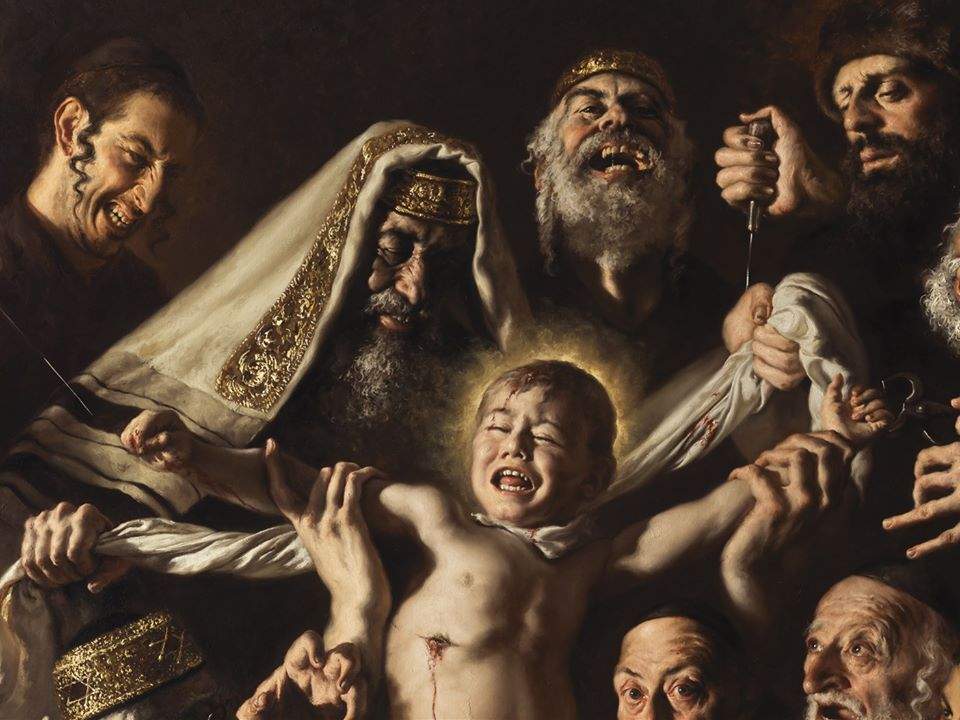An Italian painter's anti-Semitic painting becomes an international case: unacceptable anti-Jewish hatred
The painting created by contemporary Italian painter Giovanni Gasparro that has as its subject the martyrdom of Simonino da Trento, a kind of 15th-century fake news, has become an international case.The story, one of the most egregious cases of anti-Semitism in the 15th century, tells of a child, Simonino da Trento, who disappeared from his home on the evening of March 23, 1475, and was found dead three days later near the home of a Jewish family. The authorities and the people of Trent, fomented by Prince-Bishop Johannes Hinderbach, blamed the alleged murder on the Jewish community, who allegedly kidnapped and killed Simonino to carry out a ritual murder.
Medieval anti-Semitism in fact attributed to Jews the practice of human sacrifice, to be carried out with previously tortured Christian children: there are no records of this practice, but the popular credulity of the time believed it to be well-founded, and as a result, after Simonino’s body was found, several Jews, all innocent, were imprisoned, tortured to confess crimes never committed, and in many cases executed. A recent exhibition organized at the Tridentine Diocesan Museum traced the whole affair in great detail through numerous works of art, not least because following the killing of Simoninus his cult spread: a cult that was made official by the Church in the 16th century, and Simoninus was also beatified. It was not until 1965 that the cult was abolished, thanks to historical expertise that established the incosistency of the accusations made against the Jewish community of the time.
Giovanni Gasparro (from Bari, class of 1983, to his credit several works found in some churches in the center-south, and exhibitions at the National Gallery of Cosenza, the Diocesan Museum of Imola and other museums, as well as at the 2011 Italian Pavilion curated by Sgarbi) therefore created a painting on this theme, then posted it on Facebook with a comment, “Martyrdom of St. Simonino of Trent, for Jewish ritual murder” (moreover, it should be noted that Simonino of Trent was never canonized). The fact that Gasparro did not contextualize the work (on the contrary: he presented it as if the cult was still in effect and without saying that the ritual murder is actually a historical forgery) has aroused the ire of hundreds of users (at the moment, his post has five thousand comments, and many express strong disapproval, and even insults to the artist).
Leading Israeli media outlets (such as the Times of Israel and the Jerusalem Post, two of the country’s most widely read English-language newspapers), as well as theAlgemeiner (the weekly newspaper of U.S. Jews), broke the news by reporting condemning comments from many in the international Jewish community. The Simon Wiesenthal Center, an organization that researches the Holocaust and contemporary anti-Semitism, called on the Church to denounce Gasparro for his work: “it’s not art, it’s hate,” they let it be known from the center, which moreover sent a formal letter to the Vatican Secretary of State Pietro Parolin expressing all disappointment over the matter. “On the eve of Passover and Christian Easter,” further stated Abraham Cooper, dean of the Simon Wiesenthal Center, “this Italian artist decided to promote this violent, lurid and long-denied slander against Jews through his art? We asked Facebook not to make their platform available for a forgery that has led to the killing and maiming of many Jews for hundreds of years.”
But condemnation is not only coming from abroad, of course. In Italy, denouncing Gasparro’s actions is the Jewish Community of Milan through its official website, Bet Magazine Mosaic. In an article signed by Ester Moscati, the picture is described as “scandalous” and “unacceptable”: Gasparro, Moscati writes, “proposes this work steeped in anti-Jewish hatred as if one felt the need, when the current fake news goes crazy, to dust off those of a dismal and gloomy past.” And yet, another comment comes from historian Gadi Luzzatto Voghera, director of the Contemporary Jewish Documentation Center Foundation: the picture, argues the scholar (who, moreover, also points out in his article the conspicuous anachronisms committed by Gasparro), “uses the manual of the ’typical anti-Semite’: the Jew is dirty, slimy, thirsty for innocent blood, driven by a phony religion (those men carry out the misdeed as Jews, dressed in ritual robes and topped with a lit menorah), greedy.”
Pictured is a detail of Gasparro’s painting.
 |
| An Italian painter's anti-Semitic painting becomes an international case: unacceptable anti-Jewish hatred |
Warning: the translation into English of the original Italian article was created using automatic tools. We undertake to review all articles, but we do not guarantee the total absence of inaccuracies in the translation due to the program. You can find the original by clicking on the ITA button. If you find any mistake,please contact us.




























